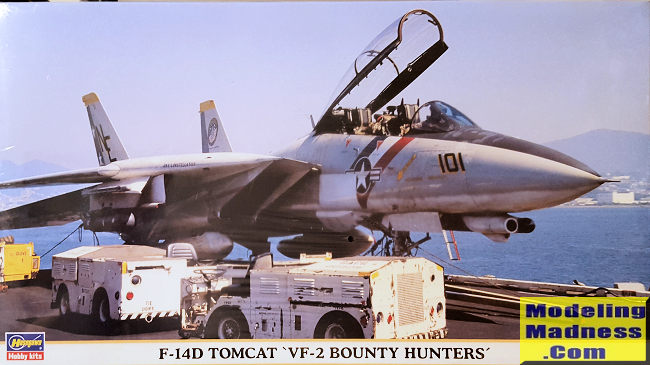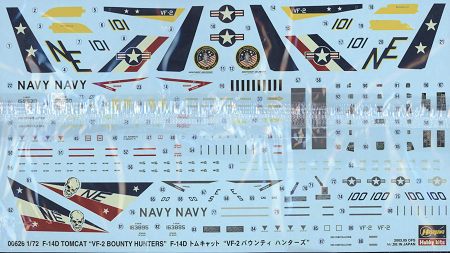
Hasegawa 1/72 F-14D "VF-2 Bounty Hunters"
| KIT #: | 00626 |
| PRICE: | 2600 yen SRP |
| DECALS: | Two options |
| REVIEWER: | Scott Van Aken |
| NOTES: | 2003 Limited reissue |

| HISTORY |
The Grumman F-14 Tomcat is a supersonic, twin-engine, two-seat, variable-sweep wing fighter aircraft. The Tomcat was developed for the United States Navy's Naval Fighter Experimental (VFX) program following the collapse of the F-111B project. The F-14 was the first of the American teen-series fighters, which were designed incorporating the experience of air combat against MiG fighters during the Vietnam War.
The F-14 first flew in December 1970 and made its first deployment in 1974 with the U.S. Navy aboard USS Enterprise (CVN-65), replacing the McDonnell Douglas F-4 Phantom II. The F-14 served as the U.S. Navy's primary maritime air superiority fighter, fleet defense interceptor and tactical aerial reconnaissance platform. In the 1990s, it added the Low Altitude Navigation and Targeting Infrared for Night (LANTIRN) pod system and began performing precision ground-attack missions.
Throughout most of its life, the F-14 was hampered by the TF-30 engines originally designed for the F-111B. These caused some issues and did not allow the full utilization of the Tomcat's design capabilities. It was planned on using F-401 engines but issues with the engines and budget concerns shelved that. It wasn't until many years later that the F-110 engine was installed in some F-14A airframes making those F-14A+ and later F-14B aircraft. The upgraded F-14D had these same engines and upgraded digital avionics with about half of the F-14D production being reworked F-14As.
In the 1980s F-14s were used as land-based interceptors by the Islamic Republic of Iran Air Force during the Iran–Iraq War, where they saw combat against Iraqi warplanes. Iranian F-14s reportedly shot down at least 160 Iraqi aircraft during the war, while only 12 to 16 Tomcats were lost; at least half of these losses were due to accidents.
The Tomcat was retired from the U.S. Navy's active fleet on 22 September 2006, having been supplanted by the Boeing F/A-18E/F Super Hornet. The F-14 remains in service with the Islamic Republic of Iran Air Force, having been exported to Iran in 1976, when the U.S. had amicable diplomatic relations with Iran.
| THE KIT |
As demanded, the panel lines are engraved and the kit offers the ability to have the flaps and slats deployed. In fact, to do it otherwise will require a bit of surgery to be done on the slat tracks. You can also position the glove vanes open or closed. Again, some surgery is needed for the closed position. All F-14s had them wired in the closed position after it was realized that they didn't really do anything and were an additional maintenance hassle. You also have the ability to have the speed brakes and entrance steps/ladder open or closed, and two different tails, though one set is not for this particular boxing. So much has the F-14 been modified and updated over the years that you really need to have photographs of the aircraft that you are modeling to get everything right.
 As required by its price, this kit comes with a small fret of
etched metal. These bits are for the interior, canopy and exhaust. The metalwork
is very well done and should really enhance your Tomcat. For this kit, they
supply the instructions for the 'F-14D Super Tomcat' boxing and an addendum sheet that shows the
D model differences. This includes a resin lower nose piece and new gun vent
doors. The
instructions are
very well done as you would expect. They offer color callouts based on Gunze
paint as is the norm with Hasegawa over the last decades. Every option and
difference between the aircraft on the decal sheet is given so that you can do a
proper job of things.
As required by its price, this kit comes with a small fret of
etched metal. These bits are for the interior, canopy and exhaust. The metalwork
is very well done and should really enhance your Tomcat. For this kit, they
supply the instructions for the 'F-14D Super Tomcat' boxing and an addendum sheet that shows the
D model differences. This includes a resin lower nose piece and new gun vent
doors. The
instructions are
very well done as you would expect. They offer color callouts based on Gunze
paint as is the norm with Hasegawa over the last decades. Every option and
difference between the aircraft on the decal sheet is given so that you can do a
proper job of things.
 For markings, we have
two aircraft. One is the box art plane in a retro scheme of light gull grey over
white with full color unit markings and insignia. This set of markings was
included in an earlier boxing (04099). New to this boxing is a set for a later
airplane in the TPS camouflage. A full set of stencils and the intake walk
markings is provided. The decals are 'old school' where the white is slightly
off white. Hot water is recommended for application of these. There are also
aftermarket decals around if you wish to go that route. As is often the case,
you get a set of standard instructions with an addendum sheet for the D variant
bits that is to be used in conjunction with the standard instructions.
For markings, we have
two aircraft. One is the box art plane in a retro scheme of light gull grey over
white with full color unit markings and insignia. This set of markings was
included in an earlier boxing (04099). New to this boxing is a set for a later
airplane in the TPS camouflage. A full set of stencils and the intake walk
markings is provided. The decals are 'old school' where the white is slightly
off white. Hot water is recommended for application of these. There are also
aftermarket decals around if you wish to go that route. As is often the case,
you get a set of standard instructions with an addendum sheet for the D variant
bits that is to be used in conjunction with the standard instructions.
| CONCLUSIONS |
Hasegawa obviously sold out quickly on kit 04099 as they used the same box art and one of the options on this one. Despite newer kits out there, this is still a very nice kit and well worth building.
| REFERENCES |
http://en.wikipedia.org/wiki/F-14_Tomcat
August 2021
Copyright ModelingMadness.com. All rights reserved. No reproduction in part or in whole without express permission.
If you would like your product reviewed fairly and quickly, please contact me or see other details in the Note to Contributors.